
As of June 15, 2025, it's crucial for Gmail users to be aware of the rising cybersecurity threats targeting email accounts. This update elaborates on the urgent need to switch from traditional passwords to passkeys for enhanced security. Google has reported that email attacks have impacted a staggering 61% of U.S. consumers, highlighting the vulnerability of conventional password systems.
In today's digital age, the security of your email account is paramount. Google's vice president of privacy, safety, and security, Evan Kotsovinos, has strongly urged the 2 billion users of Gmail to take immediate action by changing their Gmail passwords. The reality is that many individuals still rely on passwords to access their accounts, which poses significant risks to their personal data and finances.
Many people resist changing their passwords, often citing the belief that "if it ain’t broke, don’t fix it." However, this mindset can be detrimental, especially concerning cybersecurity. Kotsovinos shared alarming statistics indicating that over 60% of U.S. consumers have noticed an increase in scams, with one-third experiencing a data breach firsthand. This makes it imperative for users to rethink their reliance on traditional passwords.
Google is advocating for a shift away from passwords altogether in favor of passkeys. These new security measures are designed to be phishing-resistant and can utilize biometric data, such as your face or fingerprint, for authentication. Kotsovinos emphasized that passkeys make sign-ins easier while enhancing security.
Integrating a passkey into your Gmail account will not alter or remove any existing authentication or recovery measures. Instead, it streamlines the login process by eliminating the two-factor authentication (2FA) step, as it verifies your identity through the device itself. Given the ongoing cyber threats against Gmail accounts, transitioning to passkeys is a crucial step toward safeguarding your information.
To grasp why Google and other tech giants are promoting passkeys, it's essential to understand how they function. Steve Won, the chief product officer at 1Password, explains that each passkey consists of two components: a public key stored on the company's server and a private key stored securely on the user's device. This public/private key system ensures that passkeys are nearly impossible for hackers to guess or intercept.
Passkeys provide a robust layer of security by being resistant to phishing and other attacks. Since the private key never leaves the user's device, methods such as password-spraying and brute force attacks become ineffective. In essence, passkeys are inherently strong and secure by default, eliminating the risks associated with weak or reused passwords.
Preparation is key to successfully transitioning to a passkey. Before you begin, ensure you have the following:
A computer running Windows 10, macOS Ventura, or ChromeOS 109 or later. A smartphone with iOS 16 or Android 9 or later, Bluetooth, and screen lock enabled. The latest version of a compatible browser like Chrome, Edge, Firefox, or Safari. For iOS and macOS users, iCloud Keychain must be enabled.Once you have everything set up, follow these three simple steps to replace your Gmail password with a passkey:
Access your Google Account settings and navigate to Security Settings. Select the Passkeys option under “how you sign in to Google.” Click on “Create a Passkey” and follow the prompts provided. Verify your identity using fingerprint or facial recognition on your device, and that's it!Congratulations! You have successfully transitioned to using a passkey instead of your Gmail password, significantly reducing the likelihood of falling victim to cyberattacks.
For more information on Google passkeys and how they work, you can visit the official Google support page.